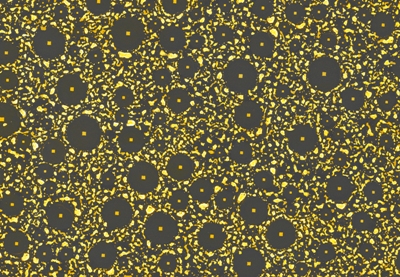Theoretical insights of a study conducted by a research team led by Junqiao Wu from the Lawrence Berkeley National Laboratory of the U.S. Department of Energy have explained in detail about the formation of nano-patterns called ‘alien’ crop circles during the annealing of a gold nanolayer over a flat silicon surface.
 When a thin layer of gold anneals on top of a silicon wafer coated with native silicon oxide, randomly distributed pools of eutectic alloy quickly form – and then go through a rapid series of strange changes, leaving behind bare silicon-dioxide circles surrounded by debris. Each denuded circle reveals a perfect square at its center. The area shown is about 107 by 155 micrometers (millionths of a meter). (credit:Lawrence Berkeley National Laboratory)
When a thin layer of gold anneals on top of a silicon wafer coated with native silicon oxide, randomly distributed pools of eutectic alloy quickly form – and then go through a rapid series of strange changes, leaving behind bare silicon-dioxide circles surrounded by debris. Each denuded circle reveals a perfect square at its center. The area shown is about 107 by 155 micrometers (millionths of a meter). (credit:Lawrence Berkeley National Laboratory)
Physical Review Letters has published the research findings online. The research team studied ultrathin films of a gold-silicon eutectic alloy, which is ideal for producing nanomaterials and nanoscale semiconductors like nanowires. The liquid state of eutectic alloys provides more obstructions, which are especially strong at the nanoscale due to the higher level of surface tension.
The research team started the experiment with a pure silicon substrate and applied a silicon dioxide nanocoating over the flat surface of the substrate. Atop this surface, the team laid pure gold layers by varying their thicknesses between a few nanometers and 300 nm from one trial to the other. The mixing of gold with the pure silicon was prevented by the silicon dioxide barrier. The team then heated the layered sample under specific conditions, which resulted in the formation of a debris-surrounded central bare silicon dioxide circular denuded zone that contained a perfect square of silicon and gold at its center.
The team discovered that the rate of expansion of eutectic circles inversely varied with the thickness of the original gold layer. The team also found a firm relation between the circle’s size and the square’s size. The circle’s radius was constantly the square’s length raised to the power of 3/2. The squares started off as weak spots, which were the sources of the expanding eutectic gold-silicon circles. Following the rupturing of the circular eutectic, the squares get packed with the same eutectic but still stayed at the center of the denuded zone. The subsequent cooling of the squares caused the separation of silicon and gold inside them, producing clearly defined edges of pure silicon and approximately outlined pure gold squares at the centers.
Wu explained that the team discovered that reacting layers’ thickness dominates the reaction rate in creating tiny gold-silicon eutectic liquids and probably in all other eutectics, paving novel ways to engineer and produce nanoscale materials.
Source: http://www.lbl.gov